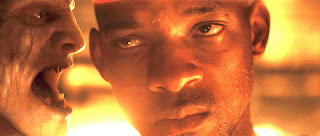 Cinefantastique Online recently noted that FirstShowing.net has posted the ending originally intended for I Am Legend which will be included on the DVD for the film to be released in stores March 18. If you have already seen the film I would encourage you to watch the alternative ending to see how it compares to the ending included in the theatrical release. After viewing it I posted some comments at Cinefantastique that I have included and expanded here:
Cinefantastique Online recently noted that FirstShowing.net has posted the ending originally intended for I Am Legend which will be included on the DVD for the film to be released in stores March 18. If you have already seen the film I would encourage you to watch the alternative ending to see how it compares to the ending included in the theatrical release. After viewing it I posted some comments at Cinefantastique that I have included and expanded here:
I understand Cinefantastique’s concerns about the alternative ending for the film, as well as the theatrical ending, and the constant refrain I hear about the ending and the film version(s) not dealing adequately with the Matheson book. But in my view the alternative ending actually fits better with the storyline where sociological considerations were concerned with Neville’s shift to completely dehumanizing the vampire zombies. His conceptual shift in dehumanizing his antagonists ends up as his downfall as the vampire zombies use their mutated form of intelligence and new social structure against Neville who is suffering from increasing inability to live with a lack of human contact. In the film the “creatures” use their intelligence to track down Neville, and their social characteristics lead them to mount a rescue mission to retrieve a fellow group member taken by Neville for experimentation related to a cure for the “creatures'” condition. In the alternative ending of the film the lead “creature” demonstrates even greater intelligence and social organization in that he communicates to Neville via symbolism, demonstrates restraint in retaliatory violence against Neville for kidnapping and experimenting on large numbers of his fellow mutated humans, and takes the captured female “creature” back to re-assimilate to the vampire zombie social structure. While the zombie creatures are certainly not “normal” human beings, perhaps in some ways they demonstrate not only an alternative form of humanity, but also one which parallels and perhaps even exceeds that of Neville himself as the representative immune human being. Granted the “over the top” CGI vampire zombies detract from this interpretation somewhat and make it far more difficult for the viewer to sympathize or identify with the mutated humans, but the alternative ending appears to me to fit more appropriately with the overall development of the storyline where the mutated humans are concerned.
Concerning the film’s failure to adhere closely to the Matheson book, since no film to day has seriously tried to do a faithful adaptation of it, perhaps we should just deal with each of the three film treatments of the story on their own terms and also recognize that they incorporate cultural elements that speak to their own times and social circumstances. For example, I ran across something recently that compared the “creatures” in the 1970s film The Omega Man with Charleton Heston to the Manson Family, and I had never made that connection. When we consider the social controversy over the new religions and the popular stereotype that they allegedly turned many of America’s youth into zombie-like people at odds with their society and family, this depiction as the “evil social other” makes sense for the time, even though it deviates from Matheson’s treatment.
But whatever version of the Matheson-inspired story we are watching, this film is filled with important social and cultural aspects for our reflection. In its current treatment aspects of the story seem to argue against the dangers of dehumanizing the “social other,” even with the best intentions of “saving them,” which seems especially important in our post-9/11 environment with the continued culture clash between the vestiges of Christendom in the West and radical Islam in the Middle East and Asia.





There are no responses yet